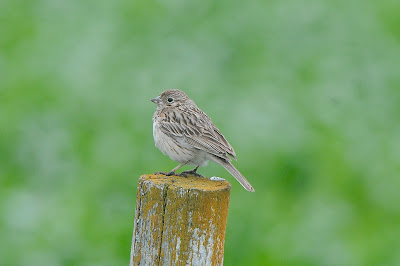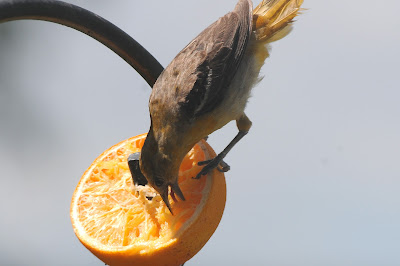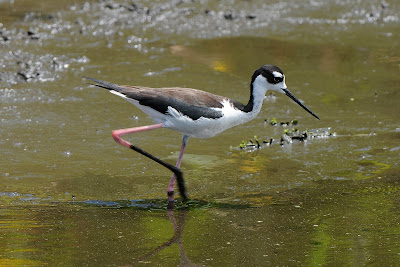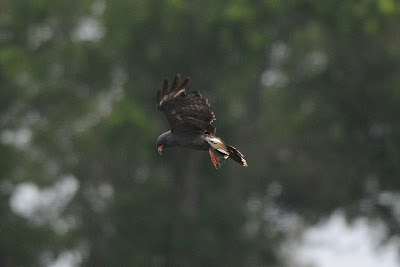You had better get comfortable; this post is devoted to some of the birds we recently saw on a trip down to Florida (and there were a LOT of them).
Why go to Florida for birds at all? Well, some exotic but countable birds are only found in Florida and as a serious birder, one HAS to go to Florida for those specialties. Florida only has 1 truly endemic species, however, the FLORIDA SCRUB-JAY. That species is not found anywhere else in the world.
Speaking of the FLORIDA SCRUB-JAY, that was our first target on our way south. Where to? The infamous Archbold Biological Station, of course (thanks Michelle). The stretch of road highlighted below is great for seeing jays perched on the powerlines:
View FLSJ in a larger map
We pulled up and sure enough, the jays were there and waiting for us. Here is a banded individual:
We made our way south to Everglades National Park. Water levels were quite low so we didn't spend as much time working wading birds like herons. We did find ourselves above this GREEN HERON at Anhinga Trail though:
Also at Anhinga Trail was this AMERICAN ALLIGATOR chomping on a catfish:
One of the only wading birds at Anhinga Trail was a bunch of WOOD STORKS. Here is one coming in for a landing:
One of the most reliable spots for BARRED OWL that I can think of has to be Mahogany Hammock in the Everglades. This trip through was no exception:
SWALLOW-TAILED KITES were common in the Everglades, we saw maybe 10-20 in the park alone. Here is one that flew by:
Down at Flamingo, there were still some AMERICAN AVOCETS at Eco Pond:
Also at Eco Pond, some nesting BLACK-NECKED STILTS:
A treat at Flamingo were the many WHITE-CROWNED PIGEONS that we saw perched and flying around. I never thought they were supposed to be so common but they were. Here is a fly-by:
As we left Flamingo, this COMMON GROUND-DOVE saw us off:
After the Everglades, we headed east into some of the lush neighborhoods in Kendall to look for established (and countable) exotics.
A target was the SPOT-BREASTED ORIOLE. I had tried for this species many times before with no luck so it was pretty high up on my nemesis list. Things didn't look good when we arrived at the prescribed intersection but we wandered around aimlessly for a few minutes. Then, as luck would have it, what's perched up on the powerlines above us? A nice SPOT-BREASTED ORIOLE:
We swung by the Kendall Baptist Hospital which is well known for the exotic species usually found there. We couldn't find what we were looking for but did come across this MITRED PARAKEET which was kind of cool:
In the neighborhood due north of the hospital, we found this HILL MYNA:
We also found 3 RED-WHISKERED BULBULS in the same neighborhood:
I don't exactly remember the name of the city park... but there was a YELLOW-CROWNED NIGHT-HERON there so I took a picture of it:
THE KEYS
A worthwhile destination if you're in the keys during spring and summer is the city of Marathon.
The Marathon Government Center has a couple of species of terns that nest on their roof! We were there specifically for a ROSEATE TERN:
Also in Marathon is a country club that has BURROWING OWLS that nest on the golf course. We swung by one evening and found two of them:
To wrap up the day, we ended at the Marathon Airport which is a reliable spot for ANTILLEAN NIGHTHAWKS. Right at 7:30 PM, a couple of them started flying around and calling:
I was surprised by how common WHITE-CROWNED PIGEONS turned out to be throughout our trip. It seems that hardly 30 minutes went by without seeing flocks of pigeons in transit:
A highlight for us on No Name Key was a pair of MANGROVE CUCKOOS. This skulking species was... well... not so skulking for us:
We reached Key West at the very tip of the keys and decided to take a look at Fort Zachary Taylor:
There wasn't a ton of variety around given the time of year and the hot, mid-day temperatures. We still managed a couple of species including this white morph GREAT BLUE HERON (sometimes referred to as Great White Heron). You'll notice that this bird has a heavy culmen and buffy legs whereas a Great Egret would have a thinner bill and blackish legs
MAGNIFICENT FRIGATEBIRDS were common and seen soaring and gliding around from just about everywhere. A few came by pretty low including this female:
We had seen GRAY KINGBIRDS just as we drove through towns on the keys. At the fort on Key West, I caught up to one "properly":
There were still a couple of migrants on Key West including SWAINSON'S THRUSH, GRAY-CHEEKED THRUSH, and this AMERICAN REDSTART:
Once we got back up to mainland Florida, we started working our way north along the eastern side of the state.
I had a couple of targets still in mind. First, I wanted to add MONK PARAKEET to my list of photographed species. Thanks to the directions of a couple of local birders, they directed us to a street in Kendall that had numerous stick nests (interestingly, this is the only species of parakeet that doesn't use a cavity for its nest). Here a couple near their nest:
I had another main target in mind, the countable WHITE-WINGED PARAKEET. Despite looking for this species at a couple of different spots, we hadn't had any luck. Based on a tip from other birders, we ventured to the Ocean Bank in downtown Miami:
A short walk later, success, we spotted a couple of high-flying parakeets zipping by. Here is one:
One of our next stops was at the Wakodahatchee Wetlands:
Honestly, I wasn't expecting much considering it was free but I was really surprised! So many species were common and many of them were used to humans being around. For example, the usually somewhat-secretive PURPLE GALLINULE was abundant here and some of them were just an arms-reach away. I had to back up to take photos of some of them!
This gallinule was feeding a young chick; you can still see the "egg-tooth" that the chick has on the tip of its bill that it used to break its shell:
The wetlands had many ages of many different species including lots of chicks. I just had to take a pic of this young RED-WINGED BLACKBIRD gaping from the nest:
The wetlands had several pairs of BLACK-NECKED STILTS as well:
I've been in the land of WHITE-FACED IBISES for the last 3 summers so it was actually a treat to be around the other plegadis ibis, the GLOSSY IBIS:
... and here is a wonky young ibis with some down still on its neck:
A duck is just a duck... and this is just a MOTTLED DUCK:
We also went to Loxahatchee National Wildlife Refuge after a target bird, SNAIL KITE. Within the USA, Snail Kites can only be found in Florida and because of their limited diet (Apple Snails), they're rather uncommon and unpredictable. We were grateful when Lox provided kites as we had hoped; here is a juvenile perched alongside a canal:
Access was best on Lee Road and we saw SNAIL KITES from that access road:
While at Lox NWR, a couple of BLACK-BELLIED WHISTLING-DUCKS zipped by. It's not a great photo but enough to prove the identity:
We were amazed at how abundant LIMPKINS were in this area. That afternoon, we spotted ~10 and sometimes from highways! Here are three together at Lox NWR:
Just for good measure, we spotted a couple of adult male SNAIL KITES hunting a canal after we had left the NWR. I pulled over for a couple of quick action shots:
A little further north we stopped at Three Lakes Wildlife Management Area for a couple of target species. Thankfully we snagged all of them.
One of the targets was RED-COCKADED WOODPECKERS and it didn't take too long before we found this banded individual:
Other targets we found included BACHMAN'S SPARROW, BROWN-HEADED NUTHATCH, and the nonmigratory, endemic subspecies of GRASSHOPPER SPARROW. We also saw many PINE WARBLERS such as this one tucked up in a pine:
We had several more SWALLOW-TAILED KITES at this location as well:
Our next target was SHORT-TAILED HAWK, a species that only nests in Florida and Arizona within the USA. We went to the Lake Wales Ridge State Forest where this species is uncommonly reliable (or so they said). Specifically, the area between the road and the lake was supposed to have nesting hawks:
View STHA in a larger map
We sat there during the heat of the day without luck for at least 15-20 minutes. Then, thankfully, a dark-morph adult came in over the trees. One very cool hawk:
At this point, we didn't have any other targets in Florida so we skedaddled northward.
We stopped at Jekyll Island in Georgia to see what shorebirds were along the beach. Most common were the ubiquitous SANDERLINGS, these in varying degrees of plumage:
We also found some WILSON'S PLOVERS by the old shipwreck which was a year bird.
We also spotted these COMMON BOTTLENOSE DOLPHINS swimming just offshore:
Another target was the secretive BLACK RAIL in North Carolina. We managed to find one at Cedar Island National Wildlife Refuge where they are said to be very common. Although we didn't witness it, it's possible to hear DOZENS of Black Rails there on the right kind of night:
We then zoomed up to coastal Virginia where I targeted more year birds such as BLACK SKIMMER, SHORT-BILLED DOWITCHER, and SALTMARSH SPARROW. The reliable marsh near Assawoman, Virginia provided SALTMARSH SPARROWS easily (just like it did last July!). I had amazing looks at 7-10 different individuals:
Even more common than the Saltmarsh Sparrows was the Atlantic subspecies of SEASIDE SPARROW:
The breeding WILLETS in the area were rather distracted by the 6'3" humanoid that smelt heavily of bug spray:
It was at this point we started our venture to northern Michigan. I didn't have much to take photos of so I started playing around with a photo I took at a rest area:
Fast-forward the rest of the way to northern Michigan where we enjoyed seeing one of the rarest warblers North America has to offer, the KIRTLAND'S WARBLER. It's not the best photo but it IS a neat bird nonetheless. We heard/saw at least 8 different individuals; here is one of them:
Finding these birds is extremely easy; they aren't more than 3 miles due east of Grayling, Michigan:
View KIWA in a larger map
Their habitat looks something like this; young (short) Jack Pines with a grassy understory:
On our way south through my old haunts in Berrien County, we stopped at Lincoln Township Beach to see the breeding (and very vocal) ALDER FLYCATCHERS:
Finding the ALDER FLYCATCHERS isn't too difficult. Just walk the boardwalk:
View ALFL in a larger map

































































